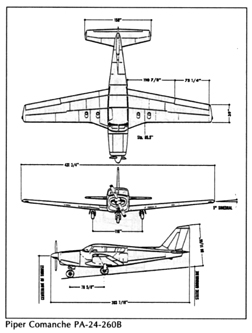

The 260B is the first "stretched" (by six inches over previous models, thanks to a longer prop spinner not a true fuselage stretch) Comanche single. They have a third side window and provision for six seats, although the fifth and sixth seats are suitable only for children and rob a lot of space from the baggage compartment. Fuel injection is standard in the B, which uses the Lycoming IO-540 of 260 hp. Empty weight is 1,728 pounds - most of which is explained by a soundproofing package that included thicker, double-paned windows. Gross weight was upped to 3,100 pounds, and useful loads rose 172 pounds - to 1,372 pounds - over that of the straight 260. Because of the extra weight, cruise speeds dropped three knots or so from the straight 260's values, but with the fuel injection came a reduction in fuel burns. These ran from 11 to 14 gph; ranges with IFR reserves go from 1,000 nm (90-gallon fuel system, 55-percent power, at 15,000 feet) to 550 nm (60-gallon fuel system, 75-percent power, at 8,000 feet). Maximum rate of climb is posted at 1,370 fpm under gross weight, standard conditions. New, 260Bs cost from $32,820 to $33,820.


